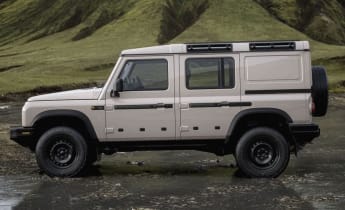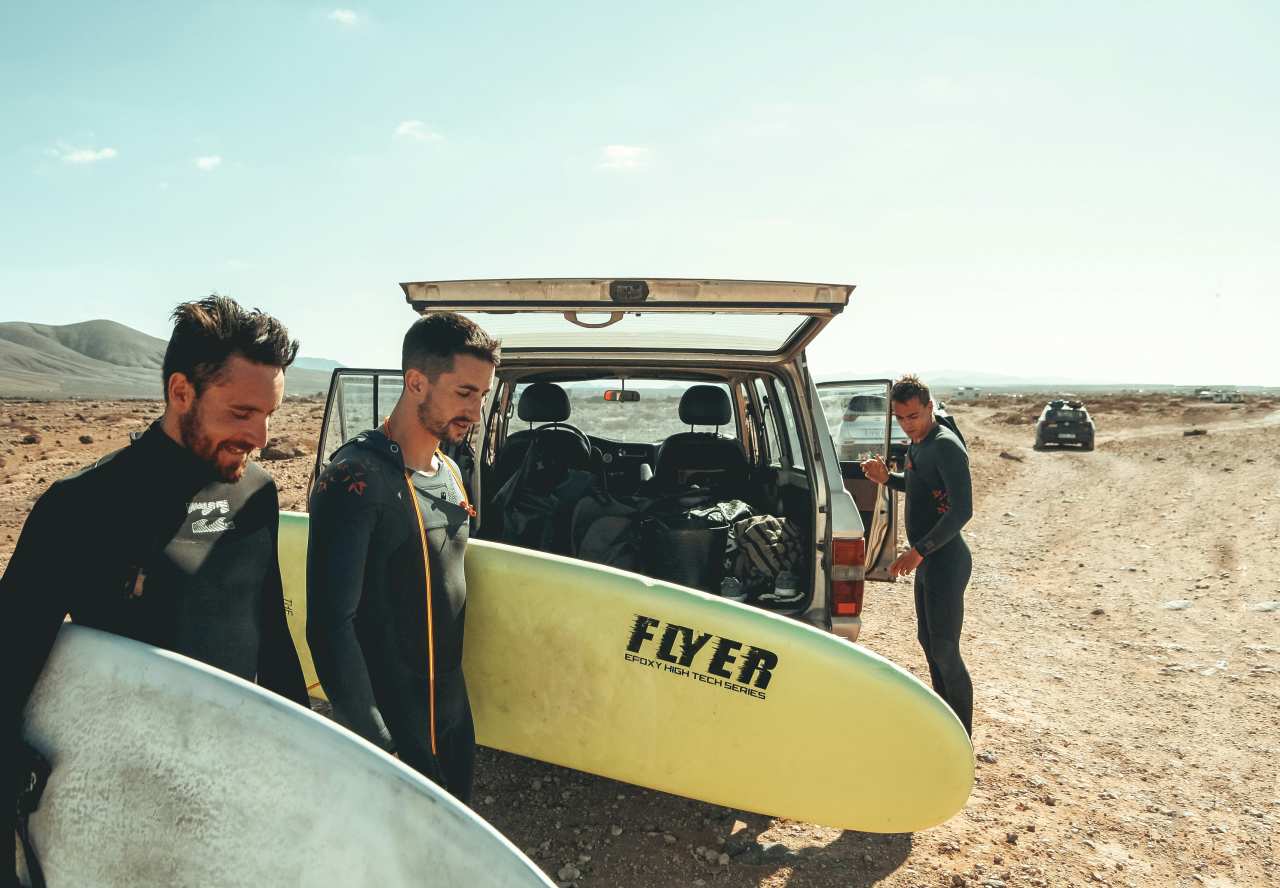Are you familiar with the expression: Be careful what you wish for? It’s an all-purpose warning against confusing what you think you want with what you really need. And it often applies to car design.
See, ever since the first soft-roader ditched its low-ratio gear-set and ladder chassis, and the first LandCruiser and Patrol swapped solid axles for an independent front suspension, hard-core bush-bashers have been crying foul.
Don’t dilute the formula, has been the outcry. Don’t bother with Bluetooth and leather trim, give us a hard-as-nails vehicle that keeps it rugged and simple. But are they right?
Well, here’s our big chance to find out, because the people at Ineos Automotive clearly hold the same values dear. And, as a result, the much-hyped Ineos Grenadier is finally here, complete with its hose-out cabin, tilt-slab styling and live axles front and rear.
Which is fine, but now, having rubbed the lamp and uncorked the genie, is the hard-headed Grenadier really what we wanted after all? Does this degree of single-mindedness have a place in modern life? Or is the Ineos the victim of its own sense of purpose?
Price and features – Does it represent good value for the price? What features does it come with?
You might want to find a comfy seat for this, because it all gets a it involved as a brand-new model with a broad array of possible configurations. But let’s start from here.
The Ineos is available initially as the Grenadier station wagon, and within that bodyshell, in three distinct specifications.
The first is the base Grenadier trim which is aimed at fleet buyers and misses out on things like extra auxiliary power outlets, the compass and altimeter, some interior tie-downs, front and rear diff locks, the rear access ladder and even the spare-wheel cover.
However, it does get the centre diff lock, choice of petrol or diesel power, 17-inch allow wheels, a Nappa leather tiller, hose-out interior, and bash plates.
.jpg)
On top of that, pretty much everything that’s not included can be optioned into the Base variant, thanks to the built-to-order nature of the production process.
From there, the range splits down two distinct paths. There’s the Trialmaster aimed at the very roughest, toughest terrain and the identically priced Fieldmaster which aims for a slightly more pampering experience for day-to-day comfort and convenience.
On that basis, the Trialmaster sticks with 17-inch allows, but wraps them in Goodrich KO2 all-terrain tyres. This model also gets the utility-belt which allows accessories to be slung off the vehicle’s sides, front and rear electric diff locks, a snorkel, the Ineos tow-pack and a dual battery set-up with the batteries located under the rear seat.
The Fieldmaster, on the other hand, gets 18-inch alloys (with locking nuts for security) leather trim, heated front seats, carpet and a premium sound system.
.jpg)
But again, more or less everything from the diff locks to the K02 tyres can be optioned on to the Fieldmaster and it seems pretty unlikely any two Grenadiers will be identical.
But, as they say on the TV adverts, that’s not all. Because if you don’t need the Grenadier station-wagon’s levels of comfort, there’s a cheaper alternative called the Grenadier Utility Wagon which does away with the rear side windows for solid panels and, interestingly, can be had as a two- or five-seater.
With cargo barriers and a hose-out interior it’s designed to be the workhorse option.
That said, like the station wagon variant, the Utility Wagon comes with the same trim level options and can be optioned right up to any level, including substituting side windows for the solid panels. Yes, it’s complex.
_0.jpg)
So is the pricing structure once you’ve factored in those options, but as it stands with no accessories or options, the range kicks off with the Utility Wagon base variant two-seater at $109,000 with either the petrol or diesel engine.
The Utility Wagon Trialmaster and Fieldmaster two-seaters are the same $122,000 regardless of which engine you choose.
Move up to the five-seat Station Wagon version and the base model lands at $110,000, leaving the Trialmaster and Fieldmaster at an identical $123,000.
.jpg)
Design – Is there anything interesting about its design?
This is where the Grenadier makes its statement. It’s resolutely old school with engineering designed to survive the roughest off-road conditions rather than pamper or flatter its occupants.
That starts with the basic construction; a ladder chassis onto which is bolted the body. This is how all off-roaders used to be made and while it has limitations in refinement and weight terms, it’s still an effective way to build something with lots of wheel articulation and strength.
Wheel articulation is also the job of the solid axles front and rear. While having independent suspension is great for ride control and comfort, solid axles allow the maximum wheel travel which is what off-roading is all about. Coil springs, rather than leaf springs, are about the only concession to comfort.
The four-wheel drive system is also traditional with a high and low-range gear set that works permanently in four-wheel drive.
.jpg)
A locking centre differential that works in high and low-range is standard and front and rear diff locks are optional. The Grenadier also complies with the old adage that a proper off-roader has a minimum of two gear-sticks, and not a rotary gear-selector knob in sight.
Even the steering system is aimed at off-road prowess with almost four turns lock-to-lock.
Such a slow ratio suits off-road work where large steering inputs are more likely to get you into trouble than out of it.
And while we now live in a world where power steering is almost always electrically-assisted, the Ineos sticks with hydraulic assistance in the name of reliability and durability and restricting electronics only to where they are essential.
.jpg)
The cabin, too, is distinctly retro with analogue gauges wherever possible and large, tactile switchgear.
But it’s also novel in layout terms with most of the information displayed on the 12.3-inch central info-screen and the area directly in front of the driver kept clear to maximise the view ahead.
The roof-mounted switch panel recalls aircraft practice and, with the Fieldmaster’s glass roof panels in place, the view is reminiscent of sitting in a military helicopter. Mounting electrical gear in the roof also keeps it out of the water during deep river crossings.
Much has been written, meanwhile, about the exterior of the Grenadier. Mainly that it looks like a copy of the old Land Rover Defender.
.jpg)
But Ineos has previously, er, defended this, claiming that when you design a car purely for functionality, its exterior will usually look something like this.
As it is, the body with its exposed door hinges (although the bolts are fake) short front and rear overhangs and even the utility belt (from which accessories can be slung) are all business.
The rough-and-tough angle even extends to details like the tyres’ valve stems which are metal rather than traditional rubber as a means of making them stronger and less likely to be damaged.
This is a thoroughly considered vehicle.
.jpg)

Practicality – How practical is its space and tech inside?
This is, of course, the Grenadier’s reason for existing in the first place. With a mantra of 'Everything you need, nothing you don’t' the Ineos attempts to be as competent, capable and practical as possible within the parameters of a car that has to also be useable, day-to-day comfortable, safe and legal.
Like a lot of high-riding vehicles, getting in and out of the relatively small door openings is not as simple as it might be. Sometimes it seems as though the side-steps are your friend, other times they exist only to smear mud all over your legs.
But once you’re in, the almost vertical windscreen and side glass keep the sun at bay and the front seats seem to be designed for big people which is a nice change.
The tilt and reach-adjustable steering column means everyone can get comfy and even though the back seat feels a bit firm in the cushion, the backrest angle is pretty agreeable.
.jpg)
It’s also nice to see that Ineos has used a proper gearstick with linkages for the high-low range shifter rather than a rotary knob to control an electric motor.
The plethora of tie-down points in the luggage compartment is great but we do wonder about the use of some fairly hard plastics around the cabin, and how they’ll look in a couple of years.
The luggage space is adequate but not hugely generous and while the rear seats do fold down, the location of the battery beneath them means they sit up a bit and don’t form a flat floor.
An accessory drawer system for the load space should fix that, however, raising the floor height to match the folded seats.
.jpg)
Maximum load volume behind the first row in the Utility Wagon is 2088 litres dropping to 2035L in the Station Wagon. Load volume in the wagon with the second row upright is 1152 litres.
There’s lot of evidence of careful thought in the way the Grenadier is laid out and equipped, including a roof that can cope with a rooftop tent or a decent load (hence the ladder) and flat front mudguards that form an impromptu work-bench or, if you add the optional checker-plate sections, a look-out post capable of supporting 150kg.
The 30/70 split tailgate has an optional drop-down work-bench when open but the smaller section is a bit narrow for gaining easy access to your luggage without also opening the larger side.
Other quibbles include the driver’s foot-rest which is huge and placed at a truly bizarre angle, and the small reverse camera screen.
.jpg)
Grouping all the instruments in the centre stack might be good for left- and right-hand drive production, but it means you have to take your eyes off the road to read the digital speedo. A head-up display in front of the driver would be much better.
Under the bonnet – What are the key stats for its engine and transmission?
This is probably the one area where the Ineos can claim to be a product of modern thinking. And that’s because the engine choices – a 3.0-litre inline six-cylinder petrol or diesel – and the eight-speed automatic transmission are all sourced from BMW and ZF, respectively.
Both engines use four-valve-per-cylinder technology and while the petrol boasts 210kW of power and 450Nm of torque.
The diesel isn’t far behind in the power race with 183kW, but trumps the petrol version for torque with 550Nm. Interestingly, the turbo-diesel engine uses all alloy construction, which, while now common in petrol units, is more of a novelty in the diesel world.
.jpg)
The eight-speed transmission feeds into the two-speed transfer-case where it’s sent to each axle via the permanent all-wheel drive system.
Ineos claims either version will get to 100km/h in under 10 seconds and top speed, in deference to the tyres as much as anything, has been limited to 160km/h.
Approach, departure and ramp-over angles are all among the best in the business and Ineos claims a safe wading depth of 800mm. The optional snorkel air-intake is likely to be a very popular addition among Australian buyers.
.jpg)
Efficiency – What is its fuel consumption? What is its driving range?
The official combined cycle fuel economy figures for the petrol and diesel engines respectively are 12.6 litres per 100km and 10.5 litres per 100km.
Realistically, these will be your highway consumption figures and the relatively hefty and aerodynamically blunt Grenadier will never be a fuel sipper. Hitch up a big caravan and use most of the vehicle’s 3500kg towing capacity and that consumption will blow out massively.
As it is, the 90-litre fuel tank should give the petrol model a cruising range of 715km or so, while the diesel should achieve closer to 850km.
It’s worth noting, too, that the diesel version uses AdBlue, so factor that, as well as the currently higher cost of diesel over petrol, into running costs.
.jpg)
Driving – What's it like to drive?
The first impression when jumping behind the Grenadier’s wheel is that the vehicle is super easy to place accurately at the front.
That’s because the two front corners are easily visible (thanks to the bluff, bull-nose front) and you sit nice and high.
In fact, the Ineos has the knack of immediately feeling smaller than it is, which is a great confidence booster for somebody new to off-roaders.
The steering also helps make a good first impression with no trace of looseness despite the slow ratio and almost four turns lock-to-lock.
.jpg)
The turning circle is also vast, and all of this makes the Grenadier anything but a car to hustle along a twisty road, but the pay-off is when you’re off-road.
In the bush is where this vehicle hits its straps, of course, and take it as read that this thing will go anywhere any other off-roader with number plates will take you.
The live axles give superb wheel articulation (at the expense of a little body roll on the bitumen) and that slow steering makes for accurate wheel placement in low-range going.
The coil springs only add to the wheel articulation, but there’s a small degree of impact harshness on patchy bitumen as a trade-off. We’d happily live with that.
.jpg)
And when you finally do run out of articulation and the Grenadier starts to spins its wheels on loose surfaces and at mind-blowing angles, you simply grab the lever for the centre differential lock and continue on.
And if that’s not enough (provided you’ve optioned them) the front and rear locking diffs turn the vehicle into the next best thing to a bulldozer.
The Ineos is also the car that proves petrol and diesel technologies are getting closer and closer to each other.
The diesel is smooth, refined and quiet, while the petrol’s twin-scroll turbocharger means it grunts like a diesel used to. Our choice would, then, probably be the diesel if only for its greater fuel economy and range.
.jpg)
The eight-speed transmission does a great job on- and off-road and is calibrated separately for the latter with the ability to second guess what’s going on and hold gears where necessary.
We’d still like to see paddle-shifters, however, as the standard T-bar shifter doesn’t allow for the sort of instinctive ratio swapping sometimes required off road.
Safety – What safety equipment is fitted? What is its safety rating?
The Grenadier is a bit of a mixed bag in safety terms with some important driver aids not available. But you do get aids such as autonomous emergency braking, stability control, hill assist, hill descent and lane departure warning.
But you won’t find blind-spot monitoring, rear cross-traffic alert or adaptive cruise-control.
The Ineos also lacks the increasingly common centre air-bag and makes do with six bags, including full-length side curtain air-bags.
.jpg)
Driver drowsiness warning and tyre-pressure monitoring are included on all Grenadiers. Crucially, too, the reversing camera is standard on all models.
The vehicle has not been independently crash tested by ANCAP, and the Australian distributor says there are no plans to do so.
Ownership – What warranty is offered? What are its service intervals? What are its running costs?
The Grenadier is covered by a factory five-year/unlimited kilometre warranty. The chassis and body components are also covered by a 12-year anti-corrosion warranty.
Service intervals are every 12 months or six months in the case of a vehicle being used in harsh conditions.
Verdict
The moral of the story here is not to confuse traditional thinking with flawed thinking. Just because an analogue concept has been around in a fast-moving, electronically-driven industry for a while, doesn’t mean it can’t still be relevant in special circumstances. And as an off-roader, the Grenadier is among the very best of them.
Yes, the Ineos suffers to an extent as a road car because of its off-road bias, but owner familiarity will likely be the key to those compromises fading into the background over time.
Meantime, it’s also true that the original design brief of the Grenadier has been diluted a little as market research and safety realities forced an extra layer of complexity on to some of the major systems.
But even the vehicle’s systems that have remained analogue or old-school have forced their own technology into the frame. The live front axle, for instance, forced the use of recirculating ball steering rather than rack-and-pinion, while Ineos also insisted on the more complex (but arguably more reliable) hydraulic power steering rather over a simpler electric set-up.
Look closely and it’s easy to see how keeping a car rugged and serviceable can become a technically involved process. Simplicity, it seems, can easily breed complexity. It was probably Dolly Parton who put it best when she said, "It costs a lot of money to look this cheap".
Note: CarsGuide attended this event as a guest of the manufacturer, with meals and accommodation provided.
Pricing Guides

Range and Specs
| Vehicle | Specs | Price* |
|---|---|---|
| Quartermaster | 3.0L, 8 SPEED AUTOMATIC | $110,000 |
| Quartermaster | 3.0L, Diesel, 8 SPEED AUTOMATIC | $110,000 |
| Quartermaster Fieldmaster ED | 3.0L, 8 SPEED AUTOMATIC | $123,000 |







.jpg)

.jpg)
.jpg)

.jpg)




.jpg)
.jpg)
Comments